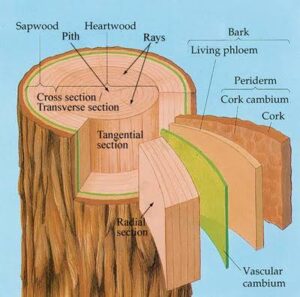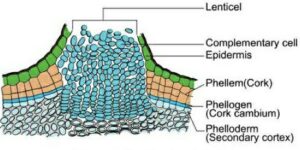Back to: Botany 300 Level
Hello, my brilliant friend! I hope you’re doing great today! Have you ever touched the rough bark of a tree and wondered how it forms? Or noticed the tiny openings on the bark and thought about what they do? Trees don’t just grow taller—they also protect themselves by developing bark, lenticels, and other protective layers. These structures help plants survive in harsh conditions, and today, we’re going to understand how they form and why they are important!
Formation of bark, lenticels, and protective layers
Formation of Bark
Bark is the protective outer covering of trees and woody plants. It forms as part of secondary growth, replacing the delicate epidermis with a stronger, thicker layer.
The process of bark formation involves the activity of two important tissues:

Vascular Cambium – Produces secondary xylem (wood) inside and secondary phloem outside.
Cork Cambium (Phellogen) – Forms periderm, which replaces the epidermis.
The periderm consists of:
Phellem (Cork) – Outer dead cells that are waterproof and protect the plant.
Phellogen (Cork Cambium) – A meristem that produces cork cells.
Phelloderm – Inner living tissue that helps in nutrient storage.
As new layers of cork form, older ones accumulate, eventually creating bark. This rough outer layer protects the plant from injury, diseases, and water loss.
Formation of Lenticels
Lenticels are tiny pores or raised spots on the bark that allow gas exchange. Since the cork layer is impermeable to air and water, lenticels serve as breathing holes for the plant.
How do lenticels form?
When the cork cambium (phellogen) becomes active, some cells in the cork layer remain loosely packed instead of becoming tightly sealed.
These gaps form lenticels, allowing oxygen to enter and carbon dioxide to exit.
Lenticels are most visible on plants like mango, guava, and cherry trees.
Formation of Protective Layers
As trees grow, they develop multiple protective layers to shield themselves from environmental stress. These include:

Cork Layer (Phellem) – Prevents water loss, infections, and mechanical damage.
Dead Outer Bark – Older layers of bark become dry and hard, adding extra protection.
Lenticels – Maintain gas exchange while preventing excessive water loss.
Why Are Bark, Lenticels, and Protective Layers Important?
Protection – Shields the tree from insects, fungi, bacteria, and harsh weather.
Prevents Water Loss – Cork cells contain suberin, a waterproof substance.
Allows Breathing – Lenticels ensure a steady flow of oxygen for inner tissues.
Aids Growth – The bark provides structural support for the plant.
A Simple Story to Understand This Process
Imagine you are preparing for the rainy season. You wear a raincoat (bark) to protect yourself, but you also need air holes (lenticels) to breathe! Similarly, trees develop bark for protection and lenticels for gas exchange to keep them healthy.
Summary
Bark forms from the vascular and cork cambium as part of secondary growth.
Lenticels are small openings on the bark that help with gas exchange.
Protective layers, including cork and dead bark, prevent water loss and damage.
These adaptations help trees survive in different environments.
Evaluation
- What are the two main tissues involved in bark formation?
- What is the function of lenticels?
- Why is cork waterproof?
- How do protective layers help plants survive?
- Name one tree where lenticels are visible.
You are doing an amazing job! Now, whenever you see a tree’s bark, you’ll know it’s more than just a rough surface—it’s a shield for survival! Keep learning with Afrilearn, and I’ll see you in the next exciting lesson. Stay curious and keep growing!
